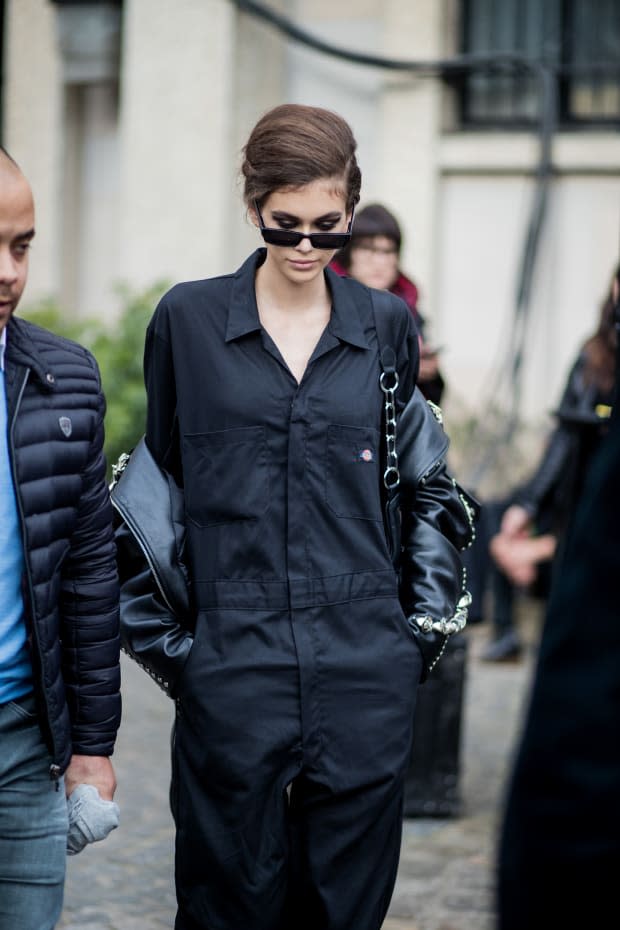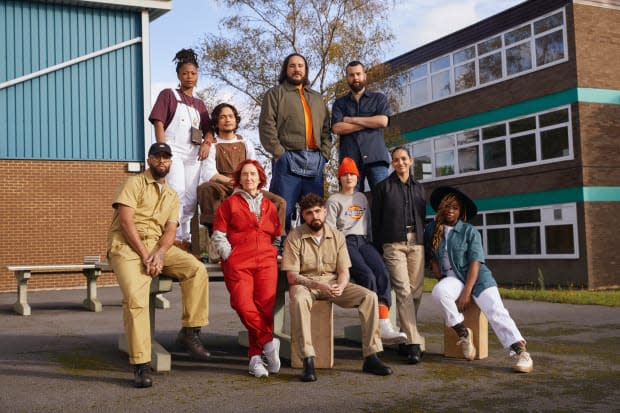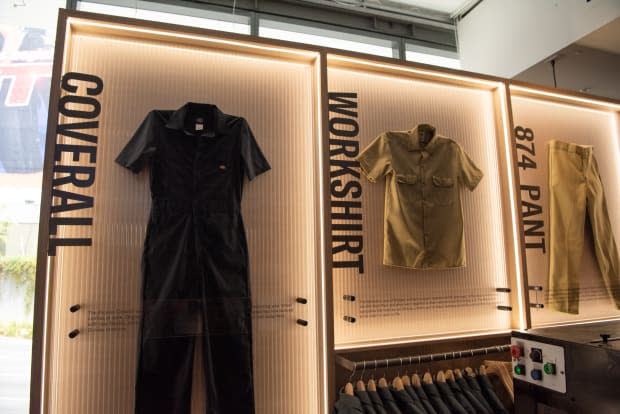Dickies Is Leaning Into Fashion While Staying True to Its Workwear Roots
The almost-100-year-old company is being intentional about how it engages with its fashion-minded consumers without alienating or taking away from its core customers: manual laborers.
It's not exactly news that utility-focused workwear has been embraced by troves of people who admire it for style over function. For the past several years, brands like Carhartt, Dickies and Wrangler have been hanging in the closets of artists, musicians, fashion editors, art directors, influencers and Urban Outfitters shoppers. Never mind that these jumpsuits, carpenter pants, overalls and chore jackets were originally designed for manual labor — something that probably isn't in the job description of most of the creative coastal elites driving this trend.
A pretty-stylish male friend of mind who works as a graphic designer at an agency in Los Angeles is the sort of person you might expect to wear Dickies pants or Carhartt jackets to work, but he has a hard stance against them: Ethically, he takes issue with the glamorization of the "working-class" uniform. As someone with a relatively cushy desk job, he feels it would be like dressing up in a costume.
This take got me thinking. How do the brands themselves navigate engaging with and catering to the more fashion-minded consumers who've chosen to adopt this aesthetic (because it would be bad business not to) without straying from their workwear roots, because doing that might alienate that core, blue-collar customer, without whom they wouldn't exist?

Photo: Phillip Caruso/Courtesy of Hulu
Earlier this summer, I stopped by beloved L.A. boutique Fred Segal to check out Dickies' first-ever pop-up shop within a fashion-centric retailer, and it became clear that this question has also been top of mind for the Fort Worth, Texas-based workwear brand, which turns 100 next year. The pop-up was a big deal for the brand, which only has a handful of branded stores in the U.S., all of which target those who specifically rely on it for functional workwear. It signaled a big step towards embracing that fashion customer.
Not that it needed to: As with so many other brands that have been adopted by communities other than the ones they were originally intended for (see: Vans, Patagonia, Champion), Dickies had little if anything to do with that initial outside adoption.
"We've been adopted by some cultures for decades and decades; the music community has been adopting us for as long as we can remember. And if you think about it, not only the artists love us, but the people behind the scenes who build the sets, who build the stages, they're also wearing Dickies," says Kathy Hines, Dickies VP of marketing. "Also, different sub-cultures in the West Coast, like the L.A. Latino community, have been adopting us for a really, really long time." There's also, of course, the skateboarding community, where so many fashion trends start: "They need the most longstanding, durable apparel in the world while they're skating, and there's nothing more durable than a product intended for heavy manual labor. It just so happens that it works for skate as well."

Photo: Christian Vierig/Getty Images
Dickies has engaged with fashion more in the past five years or so. It had a long and successful partnership with Opening Ceremony (R.I.P.) and collaborated with the likes of Stussy, Madewell, L.A. menswear boutique Union, Toga and more. Most recently, in July, it partnered with Halsey's About Face makeup line to create two handbags. These helped revitalize the brand and grow its consumer base.
In 2017, Dickies was acquired for $820 million by VF Corp., a public company that also owns Vans, North Face, Wrangler and, as of last year, Supreme. Clearly, the company saw an opportunity for Dickies to grow even more.
As Hines explains, authenticity has been crucial to hold onto through all of this, because losing that would ultimately mean losing the brand's initial appeal. "One of our greatest strengths is our authenticity and our truth as a workwear brand, and that's something that we really, really hold very central and we're very disciplined about, because that's why we're embraced," she says.
Take collaborations — rather than allow other brands to put the Dickies logo on anything, the brand approaches these partnerships carefully and strategically.
"One of the things that we try to consider is rooting it in things like our iconic product, because that keeps it really unique and connected to us," Hines says. "If we invented some collection — I don't know, I'm just gonna make it up, but — outdoor jackets and boots and sweatshirts, something that's not strongly connected to our iconic blue-collar workwear, then that could put us at a risk of them going away from the brand, because then you're just putting your logo on something that's not true to who we are."

Photo: Courtesy of Dickies
Dickies recently debuted a campaign spotlighting what it calls its five Icons: the 874 Work Pant, Work Shirt, Coverall, Bib Overall and Eisenhower Jacket. It's these iconic products that have been adopted by fashion the most and, though Dickies doesn't disclose financial figures as a brand, they've likely also driven the most revenue. Dickies likes to describe them as "a blank canvas for self-expression" — they're also what shoppers can pick up at the Fred Segal pop-up; throughout it's duration, there have also been opportunities to have these items customized on-site with different illustrations and embroideries.
"Dickies had actually never celebrated the five iconic products," says Hines. "We just felt like it was a really, really good opportunity to introduce them formally, to talk about them and showcase them, both from a workwear perspective as well as a more work-inspired or lifestyle perspective. The timing is also intentional because we're celebrating our 100 years starting March of 2022."
Another tactic Dickies uses to ensure it's still prioritizing and honoring — and not alienating — its original workwear consumers is by having separate product teams, one that focuses on performance workwear and one that focuses more on the workwear-inspired apparel.
"The way that we don't alienate them is we take them very, very seriously," Hines says. "We call our workers our athletes, because they are: They bend, they lift, they're doing heavy-duty things that require performance. Keeping that front and center and always knowing that we're there to serve the workers and enable them to do their work more effectively with our performance workwear, that really serves us well."

Photo: Courtesy of Fred Segal
In addition to catering more to fashion-minded consumers, Dickies has also, in the past couple of years, made more of a conscious effort to cater to women, starting by addressing a growing cohort of underserved female workers.
"We always say it: Without workwear, there's no workwear-inspired," says Hines. "If we don't start from a place of authenticity — and for that woman who's doing blue-collar work or heavy-duty work — then we would be entering the women's market without authenticity."
She draws a parallel to the athleticwear industry, which is still only in the early stages of catering to women in the same way it caters to men: "Men's product was the priority. I remember we would say that you would 'shrink it and pink it.' We're seeing this in the workwear industry; it's historically very male. As we see women coming in, if we're just conscious and treat her with the respect that she deserves as a worker who requires performance on the job, that's our place of truth, that's our place of authenticity. Then, when we do lean into lifestyle or work-inspired [product], it's from a place of a strong foundation."
Hines is careful not to reveal too many details about what Dickies has planned for its 100th year, but it's clear that more womenswear and fashion-centric activations are on the horizon, while its commitment to those iconic products and manual laborers hopefully remains steady. Still, with the backing of a public company and the responsibility to shareholders that comes with it, there's always pressure to chase growth — and a risk of overextension. (Say, too many collaborations, or ones that don't quite fit.) At least for now, Dickies seems to be on steady ground: It's accessible and respectful of the people who think it's cool, and the people who originally made it cool.
Never miss the latest fashion industry news. Sign up for the Fashionista daily newsletter.
